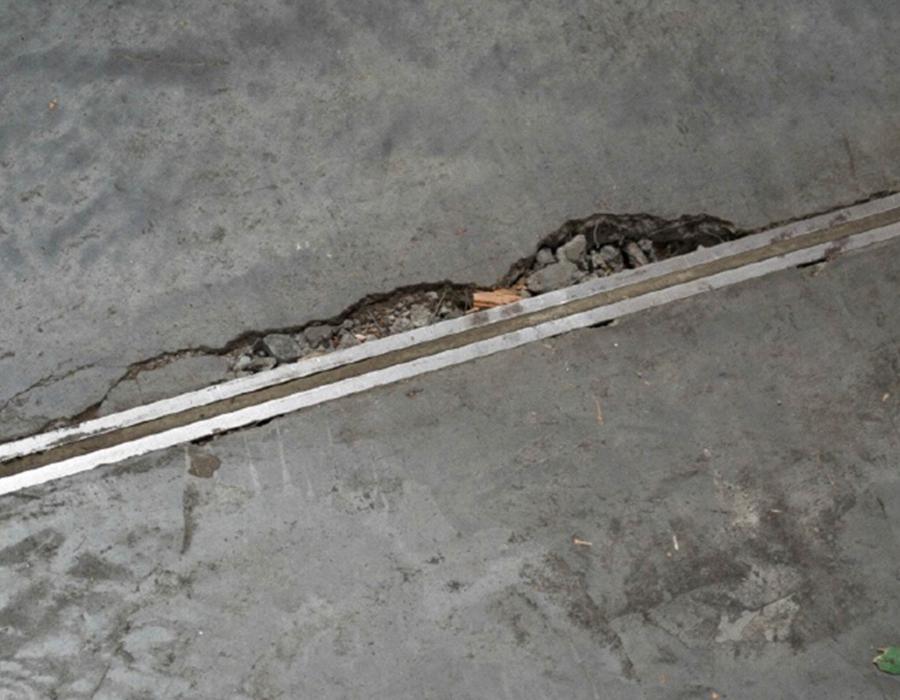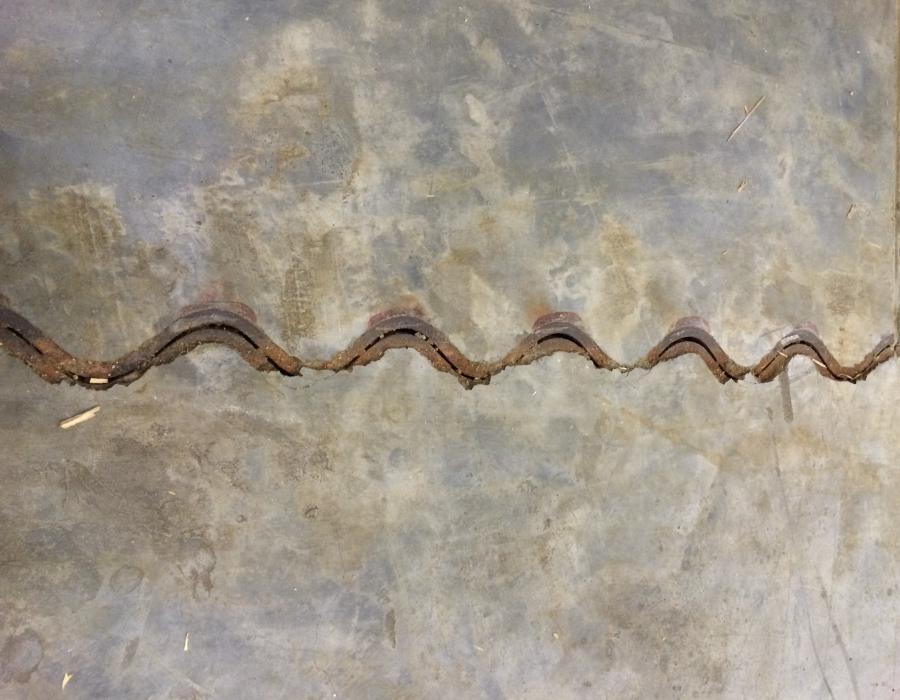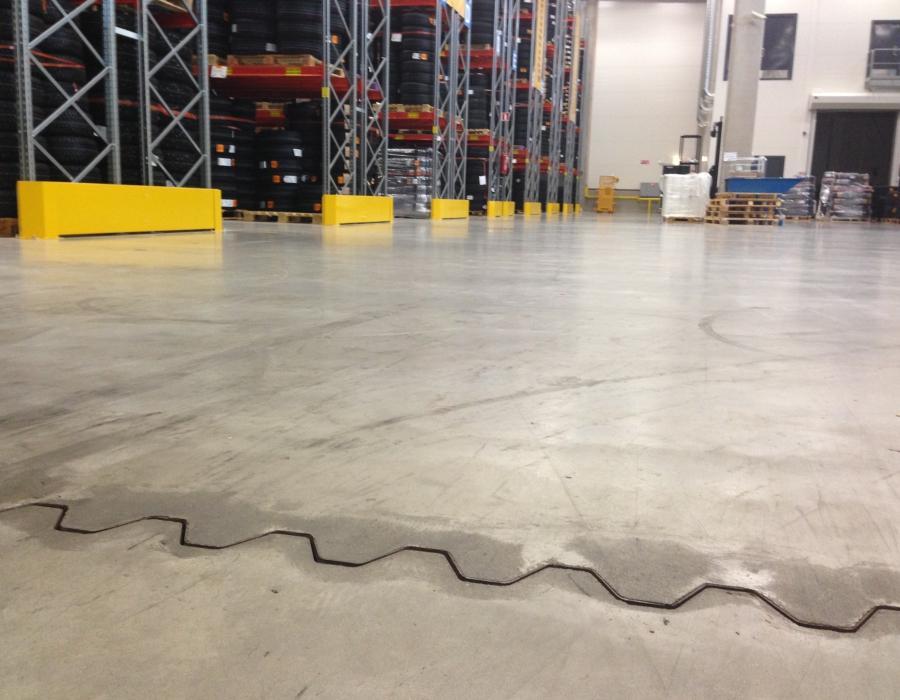Disruptive face joints: a review
Disruptive face joints: a review
by Tom Hancock, Monofloor Commercial Director
Formed construction joints are widely accepted to be the weakest part of any concrete industrial floor slab.
Over the past 20 years there have been huge changes to the way in which formed construction joints are built and protected. Armoured joints are now considered a prerequisite in the design and construction of industrial floor slabs. Failing to armour joints will quickly result in damage to materials handling equipment and also the floor, with repairs costing dearly, both financially and in operational downtime (see Figure 1).
Protecting vulnerable arrises by means of a 10mm-wide steel section became the industry norm. However, it is generally understood that protecting joints in this way only extends the life of a joint. The problem is that the straight edges of the joint allow wheel impact, which eventually causes damage (see Figure 2). Therefore in highly trafficked areas, ongoing maintenance and repair may be required throughout the working life of the floor.
Disruptive face joints
To overcome this problem, the industry has turned to shaping the arris of the formed joint in such a way as to prevent wheel impact. Products that shape the arris are now widely available.
Plate-type joints
Rather than shaping the arris, plate-type joints cover the formed gap in the joint. As the hidden formed joint opens due to drying shrinkage, the sinusoidal shape shown in Figure 3 opens by the same amount. The maximum width the joint can open is typically limited by the ‘amplitude’ of the sinusoidal wave. Care should be taken to ensure that the steel plates remain impact-free when trafficked.
While the original joint is hidden under a steel plate, the product inadvertently introduces two new ‘joints’ where the concrete meets the plate as seen in Figure 3. Here, the concrete is particularly susceptible to deterioration if the joint is not installed planar to, and at the same level as, the finished concrete. The comparatively heavy nature of the product means that installation can be difficult. However, trowelling the joint is no different to any other traditional ‘straight’ armoured joint and this means a good trowel finish can be achieved.
Different manufacturers offer different ways of providing load transfer across the joint and the ultimate load-transfer capacity of the product should be checked as part of the design review process. Compacting concrete effectively under the plate can prove troublesome and voids must be removed for the designed load-transfer value to be used fully when in service.
Sinusoidal type joints
Sinusoidal joints shape the joint arris directly to overcome the problem shown in Figure 3. Typically manufactured using 5mm gauge steel, the product also offers impact protection to the arris if the maximum joint width permitted by the sinusoidal shape is exceeded. The sinusoidal profile can be difficult to trowel to a high standard as shown in Figure 4.
Load transfer is provided by means of continuous plate dowels or discrete dowels. Others provide load transfer through the interlocking behaviour of two overlapped sinus profiles at the joint. Care should be taken when incorporating these joints into a design – the load transfer capacity of the product should always be checked using the recommendations of Technical Report 34 Fourth Edition(1).
Hex-shaped joints
Rather than sinusoidal in nature, other products shape the arris with a hexagonal profile. As with the sinusoidal products, the maximum joint width is a function of the wave geometry; however, most hex-shaped joints are designed to accommodate greater joint openings.
Some shape the joint to the full depth of the slab and this should be considered during the design process. Load transfer is typically provided by discrete dowels, as recommended in TR34.
The gauge of steel typically used can be less than that found on sinusoidal products. This means that arris protection is not provided if the joint width exceeds the designed value.
However, it also means that this type of product can be easily ground and so is suitable for use in defined movement aisles where surface regularity rectification by grinding could be required post-construction (see Figure 5). It also means that poor trowelling around the product can be rectified by polishing.
Remarks
While ‘disruptive face joints’ make a giant step forward in how formed construction joints are protected, the use of these products must be carefully considered. Designers must consider the maximum shrinkage the concrete will undergo and the likelihood of curling of the floor.
There are many disruptive joint products to choose from, all with different strengths and weaknesses. Consideration should perhaps be made to using products that provide an industry-recognised means of load transfer and allow for joint rectification in the future.
All products used must also fully conform to the Construction Products Regulation(2).
[References]:
- CONCRETE SOCIETY. Concrete industrial ground floors – a guide to design and construction. Technical Report 34, Fourth Edition, The Concrete Society, Camberley, 2013, Third impression March 2016.
- EUROPEAN UNION. Regulation (EU) No 305/2011 of the European Parliament and of the Council of 9 March 2011 laying down harmonised conditions for the marketing of construction products and repealing Council Directive 89/106/EEC (1). Official Journal of the European Union, Vol.54, 4 April 2011, Brussels, Belgium.
[Figure captions]:
[Figure 1]: Non-armoured construction joint after trafficking.
[Figure 2]: Damage to straight joint.
[Figure 3]: Damage to plate type disruptive face joint.
[Figure 4]: Poor finishing to sinusoidal joint.
[Figure 5]: Hex-shaped joint after rectification.
Latest Technical Advice and Articles
Disrputive face joints - a review
Formed construction joints are widely accepted to be the weakest ...









